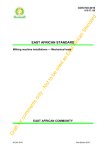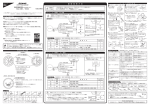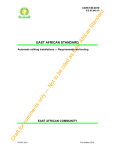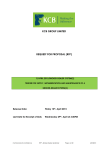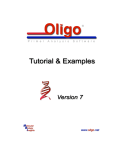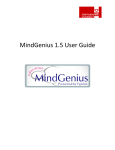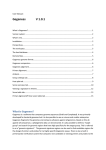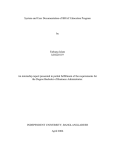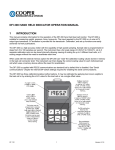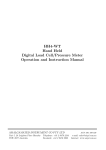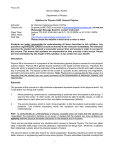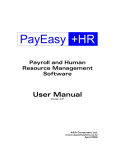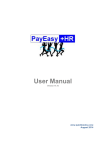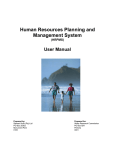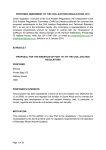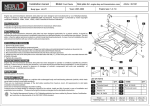Download Draft for comments only — Not to be cited as East
Transcript
CD/K/014:2008 Af ri c an St an da r d ICS 03.120.20; 43.180 Ea st EAST AFRICAN STANDARD EAST AFRICAN COMMUNITY Dr a ft f or co mm en ts on ly — No t to be cit ed as Code of practice — Vehicle test station evaluation © EAC 2010 First Edition 2010 da r d CD/K/014:2008 an St an Foreword Development of the East African Standards has been necessitated by the need for harmonizing requirements governing quality of products and services in East Africa. It is envisaged that through harmonized standardization, trade barriers which are encountered when goods and services are exchanged within the Community will be removed. st Af ri c In order to meet the above objectives, the EAC Partner States have enacted an East African Standardization, Quality Assurance, Metrology and Test Act, 2006 (EAC SQMT Act, 2006) to make provisions for ensuring standardization, quality assurance, metrology and testing of products produced or originating in a third country and traded in the Community in order to facilitate industrial development and trade as well as helping to protect the health and safety of society and the environment in the Community. ed as Ea East African Standards are formulated in accordance with the procedures established by the East African Standards Committee. The East African Standards Committee is established under the provisions of Article 4 of the EAC SQMT Act, 2006. The Committee is composed of representatives of the National Standards Bodies in Partner States, together with the representatives from the private sectors and consumer organizations. Draft East African Standards are circulated to stakeholders through the National Standards Bodies in the Partner States. The comments received are discussed and incorporated before finalization of standards, in accordance with the procedures of the Community. be cit Article 15(1) of the EAC SQMT Act, 2006 provides that “Within six months of the declaration of an East African Standard, the Partner States shall adopt, without deviation from the approved text of the standard, the East African Standard as a national standard and withdraw any existing national standard with similar scope and purpose”. No t to East African Standards are subject to review, to keep pace with technological advances. Users of the East African Standards are therefore expected to ensure that they always have the latest versions of the standards they are implementing. © East African Community 2010 — All rights reserved* — East African Community P O Box 1096 Tanzania ts on ly Arusha Tel: 255 27 2504253/8 Fax: 255-27-2504481/2504255 mm en E-Mail: [email protected] ft f or co Web: www.each.int Dr a * ii © 2010 EAC — All rights of exploitation in any form and by any means reserved worldwide for EAC Partner States’ NSBs. © EAC 2010 — All rights reserved da r d CD/K/014:2008 an St an Contents Scope ...................................................................................................................................... 1 2 Normative references .............................................................................................................. 1 3 Definitions ................................................................................................................................ 1 4 Organization ............................................................................................................................ 2 5 Quality management system ................................................................................................... 3 Ea st Af ri c 1 as Annex A (normative) Facilities and equipment requirements ................................................................. 10 ed Annex B (normative) Inspectorate authority — Technical enquiry ...................................................... 12 cit Annex C (normative) Customer complaint ........................................................................................... 13 be Annex D (normative) Testing authority — Throughput times/vehicle ....................................................... 14 t to Annex E (normative) Wheel alignment gauges ..................................................................................... 15 Dr a ft f or co mm en ts on ly — No Annex F (normative) Roller brake tester ............................................................................................... 17 © EAC 2010 — All rights reserved iii ft f or Dr a ts on ly mm en co — t to No be ed cit as st Ea da r an St an Af ri c d CD/K/014:2008 da r d EAST AFRICAN STANDARD 1 an St an Code of practice — Vehicle test station evaluation Scope 1.2 The principal grades intended for such authorities are as follows: Af ri c 1.1 This standard covers general provisions for the evaluation of the technical competence of a vehicle test station authority. It also serves as a basis for determining the grading and registration of the authority on the grounds of its adherence to the provisions of this standard, the suitability of the equipment and the competence of registered examiners of vehicles employed. grade A – examination and testing of any class of vehicle; and b) grade B – examination and testing of motor vehicles other than a goods vehicle or a bus of gross vehicle mass exceeding 3 500 kg. Ea st a) Normative references cit 2 ed as 1.3 In addition, where the population of a rural area does not justify the introduction of a permanent vehicle test station, a mobile vehicle test unit that complies with the provisions of this standard and that is confined to a specific area should be allowed. be The following referenced documents are indispensable for the application of this East African Standard. For dated references, only the edition cited applies. For undated references, the latest edition of the referenced document (including any amendments) applies. t to CD/K/005:2008, Motor vehicle safety — Rear underrun protection devices — Specification No EAS 500:2010, Code of practice — Testing of motor vehicles for roadworthiness CD/K/039-1:2008, Motor vehicle safety — Braking — Part 1: General — CD/K/039-2:2008, Motor vehicle safety — Braking — Part 2: Response time of braking devices on vehicles fitted with compressed-air braking devices ts on ly CD/K/039-3:2008, Motor vehicle safety — Braking — Part 3: Energy sources and reservoirs CD/K/040:2008, Measurement of noise emitted by road vehicles when stationary — Code of practice CD/K/044:2008, Wheel flaps fitted to motor vehicles ⎯ Specification Definitions mm en 3 For the purposes of this standard, the following definitions apply: co 3.1 acceptable acceptable to the national inspectorate authority Dr a ft f or 3.2 audit systematic investigation by the appointed inspectorate, with proof of this appointment, to determine a vehicle test station authority's adherence to established procedures and to this standard as mandated by the relevant national legislation (see foreword) © EAC 2010 — All rights reserved 1 d CD/K/014:2008 an St an da r 3.3 calibration comparison between an instrument and a measuring standard of higher accuracy to detect, correlate, adjust and document the accuracy of the item being calibrated 3.4 corrective action any change introduced into the equipment, methods, procedures or sequence of the system in order to prevent the recurrence of a specific deficiency in the product, service or system Af ri c 3.5 customer applicant person or persons who require(s) or obtain(s) services rendered by a vehicle test station authority Ea st 3.6 floor working space floor level in an inspection pit on the lowest level that allows the vehicle examiner free and unimpeded access to the vehicle and the underside of the vehicle ed as 3.7 national inspectorate authority organization appointed as such by the relevant minister be cit 3.8 procedure documented description of an activity, including the sequence of operations, methods to be employed and equipment to be used No t to 3.9 quality system documented method of operation, based on this standard, which identifies the activities and establishes controls of an organization — 3.10 roadworthiness descriptive of a vehicle that complies with the relevant national legislation and with EAS 500 ts on ly 3.11 vehicle test station authority organization whose function is to examine, measure or otherwise determine the roadworthiness of a vehicle with respect to the requirements of the relevant national legislation and with EAS 500 NOTE The vehicle test station authority is hereafter referred to as the station. 4.1 Organization mm en 4 Management representative co The station shall appoint a management representative who shall have the necessary authority for, and the responsibility of, ensuring that the levels of technical and managerial competence required for the successful evaluation of the vehicle test station in terms of this standard are maintained. ft f or The management representative shall be a registered examiner of vehicles, or b) be in possession of a related technical qualification. Dr a a) 2 © EAC 2010 — All rights reserved d CD/K/014:2008 da r Where a management representative was appointed without compliance with (a) or (b) above, such a qualification shall be obtained within a period of two (2) years. 4.2 an St an NOTE For the interim appointed management representatives may be trained by an approved service provider approved by the national inspectorate. Field of application and methods The station shall ensure that its organizational structure is clearly documented in the form of an organogram, b) the field of application of the station, as recommended by the appointed inspectorate authority and determined by the relevant national authority, is clearly stated by its grade, and c) all methods and procedures used in each activity are clearly documented and, in particular, that the procedures for continuous co-ordination with the appointed inspectorate authority are clearly stated. Policy documentation as 4.3 Ea st Af ri c a) ed 4.3.1 The station shall develop and shall effectively maintain clear and concise documentation of its policy regarding cit a) inspection management, as required by the provisions of this standard, b) the legality of procedures and operations, be c) general good housekeeping, and t to d) good public relations. No 4.3.2 Rules and measures for ensuring the protection of proprietary rights and confidential information shall be instituted and shall be effectively maintained. — 4.3.3 Procedures shall be laid down for the periodic review of organizational matters, the documentation (including amendments thereto), and the written notification and distribution thereof to all parties concerned. ts on ly 4.3.4 Rules and measures shall be instituted and shall be effectively maintained to limit the vehicle inspection and testing activities of the station to those covered by the relevant provisions of EAS 500. 4.3.5 Provision shall be made in relevant documentation for the authorized access of the appointed inspector to all applicable documents and procedures. 5 5.1 The policy statement of the vehicle test station shall be placed on permanent public display. mm en 4.3.6 Quality management system Quality documentation and documentation control ft f or co 5.1.1 The station shall operate in accordance with a formalized quality system that is appropriate to its authorization and to the range and volume of vehicle inspections performed. All procedures related to the quality system shall be so documented as to cover all the provisions of this standard and any such further procedures deemed necessary for the assurance of good housekeeping. Dr a 5.1.2 Documentation shall be so presented that each person involved with inspection matters is aware of both the extent and the limitations of his/her area of responsibility. © EAC 2010 — All rights reserved 3 d CD/K/014:2008 an St an da r 5.1.3 The preparation, approval and implementation of any changes, amendments or modifications to any work instruction or test method shall be clearly defined and any amendments to existing documents shall indicate the date and the author or source of the amendment. 5.1.4 The station shall establish and maintain a system to control all documentation that relates to the provisions of this standard. The system shall ensure that the latest issues of the following mandatory documents are available at all points of issue or use: 1) for grade A: CD/K/005:2008 and CD/K/044:2008; and 2) for grades A and B: this standard, CD/K/041:2008, CD/K/039:2008 (parts 1, 2 and 3), CD/K/006:2010, and the relevant national legislation (see foreword), Af ri c a) all amendments to documentation are in writing and are processed in a manner that will ensure prompt response, c) records of amendments are updated as the amendments are made, d) an updated document (incorporating any amendments) is issued promptly, and e) provision is made for the prompt removal of obsolete documents from all points of issue or use. Ea as ed Review of the quality management system cit 5.2 st b) be 5.2.1 The continued effectiveness of the quality system established in accordance with the provisions of this standard shall be ensured by an annual systematic review by the station. Records of such reviews and of any corrective action taken shall be maintained and, when relevant, made available to the inspector. Work instructions — 5.3 No t to 5.2.2 Notwithstanding and in addition to any actions performed to establish whether particular aspects of the inspection system are in compliance with documented procedures, the station shall, at such intervals as are prescribed by the management representative (see 4.1), be subjected to a comprehensive self-audit for verification of compliance of all relevant matters within the provisions of this standard, and of the documented system. ts on ly The station shall develop and maintain clear and complete documented instructions that prescribe the manner of executing the following vehicle inspection work: the distribution of documentation, b) the admission of vehicles to the vehicle test station, c) the approach to, and treatment of, customers, d) vehicle identification examination, e) the completion of inspection records, f) the payment of test fees, co the issue of roadworthiness certificates and inspection records, ft f or g) mm en a) the control of records, i) the procedures in the case of retests, j) in-house maintenance and calibration, Dr a h) 4 © EAC 2010 — All rights reserved da r d CD/K/014:2008 vehicle testing, l) the processing of vehicle test information onto the national traffic information system (NaTIS), and m) actions in the event of NaTIS failure. Corrective action 5.4.1 The station shall develop and maintain documented procedures for Af ri c 5.4 an St an k) determining the implications of any deviations from authorized procedures that occur and what corrective action such deviations require, b) the continued monitoring of procedures and records, in order to detect, eliminate and prevent any suspicious inspection results, and c) ensuring that corrective actions are effective. The station shall have procedures to be followed in the case of as 5.4.2 Ea st a) customer complaints, b) document problems, c) personnel problems, d) managerial problems, and e) administration problems (internal and external). t to be cit ed a) Personnel 5.5.1 All personnel shall be competent to perform the functions allocated to them. No 5.5 ts on ly — 5.5.2 The proportion of senior (supervisory) to junior (non-supervisory) staff should be such as to ensure effective supervision of all the work. Where relevant, one member of staff, competent in the routine work involved, shall be nominated to supervise the running of the facility in the absence of the management representative. 5.5.3 The station shall identify the training requirements for specific technical or quality assurance functions. mm en 5.5.4 Records of the qualifications and experience of each staff member and of his/her position in the organizational structure shall be available and shall be kept up to date. 5.5.5 The persons responsible for the functions given in 5.8 shall receive written authorization by the management representative to perform these functions. ft f or co 5.5.6 Vehicles shall only be examined by a graded vehicle examiner who is registered with the central register for vehicle examiners. He/she shall, at any time be able to demonstrate a sound understanding of those sections of the following documents that are appropriate to the grade of the vehicle test station: the relevant national legislation, b) EAS 500, and c) the mandatory documents in 5.1.4(a). Dr a a) © EAC 2010 — All rights reserved 5 The station shall establish a system for disciplinary procedures. 5.6 Facilities and control of testing and measuring equipment an St an 5.5.7 da r d CD/K/014:2008 5.6.1 Facilities and equipment listed in annex A, applicable to the grading of the vehicle test station, shall be maintained in a serviceable condition and be readily available for use by the vehicle test stations. A record of all such items and a means of identification shall be maintained. Af ri c 5.6.2 The equipment shall only be operated by authorized staff, or under the direct supervision of authorized staff. st 5.6.3 Information concerning items of equipment that require special instructions regarding their operation and maintenance shall be kept in files (or similar systems) that are properly maintained and readily accessible for use by the relevant personnel. Ea 5.6.4 Equipment shall be properly maintained and protected against corrosion and other causes of deterioration. An effective maintenance procedure shall be available. For each item of equipment, files shall be maintained that include cit 5.6.6 ed as 5.6.5 An item of equipment that has been damaged or is likely to give suspect results, or that has been shown by calibration or in other ways to be defective shall be clearly labelled as such and withdrawn from use until it has been repaired and calibrated or otherwise proved to be in good working order. the manufacturer's specifications, b) operating instructions, c) maintenance instructions, d) calibration recommendations, e) the date of purchase, f) maintenance work carried out, and g) the results of any calibration. ts on ly — No t to be a) 5.6.7 In the absence of a manufacturer's recommendations, equipment shall be calibrated during the periods outlined in Table 1. Table 1 — Calibration periods Dr a ft f or co mm en 1 Equipment Roller brake tester Headlamp beam checking device Wheel alignment gauge Kingpin and fifth wheel gauges Tyre tread depth gauge Measuring tapes Height gauge Straight edge Turning radius measuring device Vernier caliper 6 2 Calibration period 1 year 1 year 1 year 1 year 1 year 1 year 1 year 1 year 1 year 1 year © EAC 2010 — All rights reserved da r d CD/K/014:2008 an St an 5.6.8 Testing and measuring equipment, where appropriate, shall be calibrated before being commissioned and thereafter shall be calibrated in accordance with an established programme and schedule at appropriate intervals, dependent on the nature of the equipment and what is recommended by the equipment manufacturer. 5.6.9 The programme for calibration shall be so designed that testing equipment is calibrated by a person or organization equipped and authorized to do the work. Valid certificates of calibration for all testing equipment shall be available on site. Af ri c 5.6.10 The testing equipment shall be calibrated to an accuracy commensurate with the accuracy required in the use of the equipment. st 5.6.11 In-house reference standards of measurement held by a station shall not be used for any purpose other than calibration. Ea 5.6.12 The vehicle testing shall be stopped if any item of the relevant equipment or if the facility is not available and if no alternative arrangement can be made. However, if an alternative arrangement is made to test the vehicle, it shall be recorded on the required technical records. Subcontractors as 5.7 Technical records cit 5.8 ed The inspection or testing of a vehicle for roadworthiness shall not be subcontracted to outside parties, unless prior written permission has been obtained from the relevant national authority. be Technical records shall be kept and retained for at least five years in respect of all inspection, testing and results of calibrations, in particular the following: A co-ordinated system shall be used throughout all the separate parts of the station. b) Records in the form of loose-leaf sheets shall at all times be properly filed. c) All observations and calculations shall be recorded at the time they are made. d) The records for each inspection or test shall contain sufficient information to permit the tracing of possible sources of error and to permit, where necessary, satisfactory repetition of the inspection or test under the original conditions. e) All records shall be protected from loss, damage or misuse (where computer data facilities are used for recording purposes, precautionary measures shall have been instituted to prevent accidental erasure of data from the system). f) Any departures from any test procedure, inspection procedure, specification, work instruction or other technical procedure as originally documented shall be recorded and justified, together with authorization, where appropriate. g) The station shall keep a record of all technical work contracted to outside parties. h) A register shall be kept that contains the designation of staff members responsible for co mm en ts on ly — No t to a) maintaining the vehicle test register, 2) handling equipment maintenance work and calibration, 3) submitting statistical returns to the relevant national authority (see foreword), 4) submitting technical queries to the appointed inspectorate authority, Dr a ft f or 1) © EAC 2010 — All rights reserved 7 d CD/K/014:2008 maintaining a file on, and analysing, customer complaints, 6) establishing and analysing the average throughput times, 7) maintaining copies of the documents listed in 5.1.4(a), 8) preparing and maintaining procedures for the admission of vehicles to the vehicle test station, 9) approaching and treating customers, 10) identifying vehicles, 11) producing documentation 12) handling payment of test fees, 13) issuing of roadworthiness certificates and inspection records, and 14) procedures in the case of retests and other related matters. Statistical returns to the relevant national authority 5.9.1 Responsibility ed 5.9 as Ea st Af ri c an St an da r 5) NOTE be cit The staff member responsible in terms of 5.8(h)(3) shall submit accurate monthly statistical returns to the relevant national authority (see foreword). The staff member shall keep a file of the returns and of the comments received from the relevant national authority. The returns will be used by the relevant national authority and by the inspectorate authority to assess the following: t to a) a comparison of the number and types of vehicles being tested in different parts of the country, b) the vehicle defects that predominate nationally and by area, No c) the relative stringencies of examinations at particular vehicle test stations, compared with the national norms, and 5.9.2 Analysis of returns — d) changes over the years in the general state of vehicle roadworthiness. 5.10 ts on ly The staff member responsible in terms of 5.8(h)(3) shall regularly analyse the returns and the comments received from the relevant national authority (see foreword) and shall communicate this analysis to the appropriate personnel of the station at intervals not exceeding one month. Technical queries to the appointed inspectorate authority mm en 5.10.1 Responsibility The staff member responsible in terms of 5.8(h)(4) shall submit written technical queries to the inspectorate authority on a form as shown in annex B and shall keep a file of these technical queries together with the responses received from the appointed inspectorate authority. co 5.10.2 Analysis of technical queries ft f or The staff member responsible in terms of 5.8(h)(4) shall regularly analyse the technical queries and the responses received from the inspectorate authority and shall communicate this analysis to the appropriate personnel of the station at intervals not exceeding one month. Dr a NOTE 8 The written technical queries should be used by the inspectorate authority to a) assess when amendments, elaboration or additions are necessary to this standard, or regulations of the relevant national legislation, © EAC 2010 — All rights reserved b) ensure uniformity of approach, c) assess which vehicle test stations require aid so that liaison visits to selected areas can be planned, and d) detect emerging problems at an early stage so as to be able to advise all vehicle test stations promptly. an St an 5.11 da r d CD/K/014:2008 Customer complaints 5.11.1 Responsibility Af ri c The station shall display its customer complaints procedure to the public and all customer complaints shall be recorded. st The staff member responsible in terms of 5.8(h)(5) shall, in the event of a customer complaint, provide the customer with a complaint form as shown in annex C and shall keep a file of such completed complaint forms. Ea 5.11.2 Analysis of complaints as The staff member responsible in terms of 5.8(h)(5) shall regularly analyse the complaints and any comments and shall communicate this analysis to the appropriate personnel of the station at intervals not exceeding one month in order to achieve the objective of minimizing future complaints. 5.12 ed The complaints records will be used by the inspectorate authority to assess whether there are common problems (on a national basis) that require solutions, and, b) in cases where problems are confined to a particular area, ascertain whether these are created primarily by the stations or by the operators concerned. cit a) be NOTE Throughput times t to 5.12.1 Responsibility — No The staff member responsible in terms of 5.8(h)(6) shall compile the statistics for the vehicle test station that show the average duration of the examination (i.e. the time that passes from when the examination is started to the time when the inspection record is issued) and establish suitable norms for the station, based on an analysis of these data. ts on ly NOTE 1 The information for what is accepted as being the busiest and least busy day of the week should be compiled at monthly intervals. Seasonal peaks and lows and days when the staff complement is either abnormally high or abnormally low should be avoided for the purposes of this return. NOTE 2 A form as shown in annex D should be filled in and submitted to the relevant national authority and to the appointed inspectorate authority at six-monthly intervals. 5.12.2 Analysis of throughput times The throughput time data will be used by the inspectorate authority to co NOTE mm en The staff member responsible in terms of 5.8(h)(6) shall regularly analyse the throughput times and the comments from the inspectorate authority and shall communicate this analysis to the appropriate personnel of the station at intervals not exceeding six months in order to achieve the objectives of minimizing waiting time and ensuring a reasonable duration for the examination of a vehicle. assess the national norms, and b) advise each vehicle test station where it stands in relation to national norms, so that in some cases steps can be taken to introduce improvements. Dr a ft f or a) © EAC 2010 — All rights reserved 9 Annex A (normative) Facilities and equipment requirements Facilities and equipment A.1.1 Facilities Af ri c A.1 an St an da r d CD/K/014:2008 A vehicle test station shall have the following facilities applicable to its grading: an inspection pit with safe access for the vehicle examiner, that provides a longitudinal floor working space of at least 5 m for a grade B roadworthiness test station, and that has a motor vehicle entrance and exit, in a clearly demarcated longitudinal direction; b) an inspection pit with safe access for the vehicle examiner, that provides a longitudinal floor working space of at least 18 m for a grade A roadworthiness test station, and that has a motor vehicle entrance and exit, in a clearly demarcated longitudinal direction and has a clearance height of at least 5m, implementation date be that of publication; c) an area for checking the rearward field of vision for both grade A and grade B vehicle test stations; d) a road test area for both grade A and grade B vehicle test stations, that will allow the vehicle under test to reach its allowable operating speed; and e) for grade A vehicle test stations, an area for measuring the turning radius of the vehicle, the maximum being 17.5 m or the measuring device. For grade B vehicle test stations, the maximum is 13.1 m. Equipment No A.1.2 t to be cit ed as Ea st a) A vehicle test station shall have the following equipment applicable to its grading: a brake tester for grade A and grade B vehicle test stations that complies with the requirements of Annex F, and that is appropriate to the field of application and the grade of the vehicle test station. All brake testers shall be equipped with load sensors and printouts from 1 January 2011; b) a headlamp beam-aim checking device or screen for grade A and grade B vehicle test stations; c) a 2 000 kg hydraulic jack for a grade B vehicle test station, an appropriate play detector, or any other equipment that will allow the wear of vehicle suspension, steering and wheels to be checked; d) a 10 000 kg hydraulic jack for a grade A vehicle test station, an appropriate play detector, or any other equipment that will allow the wear of vehicle suspension, steering and wheels to be checked; e) wheel alignment gauges, for grade A and grade B vehicle test stations, that comply with the requirements of Annex E, appropriate to the field of application and to the grade of vehicle test station; ft f or co mm en ts on ly — a) f) kingpin and fifth wheel gauges for grade A vehicle test stations; Dr a g) vernier calipers for grade A and grade B vehicle test stations; h) a tyre depth gauge for grade A and grade B vehicle test stations; and i) a vehicle height gauge for grade A and grade B vehicle test stations. 10 © EAC 2010 — All rights reserved Hand tools da r A.1.3 d CD/K/014:2008 an St an The following hand tools shall be readily available at each inspection pit: a 5 m steel measuring tape for grade B vehicle test stations; b) a 30 m steel measuring tape for grade A vehicle test stations; c) a crow bar for grade A and grade B vehicle test stations for checking wear on steering and suspension assemblies; d) a plumb line for grade A and grade B vehicle test stations; e) an inspection light for grade A and grade B vehicle test stations for checking the underside or invisible areas of a vehicle; and f) a straight edge (fifth wheel rubbing plate) for grade A and grade B vehicle test stations for checking the wear on the fifth wheel. Responsibility of management representatives as A.2 Ea st Af ri c a) Dr a ft f or co mm en ts on ly — No t to be cit ed A management representative or appointed person shall be responsible for ensuring that the above facilities and equipment are adequately protected from inclement weather, as recommended by the manufacturer, that they are maintained in a good state of repair and that they are fit for use at all times. © EAC 2010 — All rights reserved 11 Annex B (normative) Dr a ft f or co mm en ts on ly — No t to be cit ed as Ea st Af ri c Inspectorate authority — Technical enquiry an St an da r d CD/K/014:2008 12 © EAC 2010 — All rights reserved da r d CD/K/014:2008 an St an Annex C (normative) Dr a ft f or co mm en ts on ly — No t to be cit ed as Ea st Af ri c Customer complaint © EAC 2010 — All rights reserved 13 Annex D (normative) Testing authority — Throughput times/vehicle Test station as Ea st Af ri c Address an St an da r d CD/K/014:2008 ed Station grade cit Province be Responsible officer Date Average waiting time before Average examination time (until issue No. of vehicles examination of inspection record) t to Vehicle type No Cars — LCV Trailers Motorcycles ts on ly HCV mm en 1) From the time the client's application form is received, to the time the inspection starts. Dr a ft f or co Number of roadworthiness certificates issued: ……………………………………………………………….. 14 © EAC 2010 — All rights reserved da r d CD/K/014:2008 an St an Annex E (normative) Wheel alignment gauges E.1 Installation Af ri c E.1.1 The wheel alignment gauge shall be installed in accordance with the manufacturer’s recommendations. E.1.2 If the installation is not carried out by the manufacturer or distributor, full installation instructions shall be provided. as Ea st E.1.3 The installation of a wheel alignment gauge shall be such that the plate is in the same horizontal plane as the floor. Where this is not possible, elevated installation is permitted, provided that the height of the plate above the floor is not more than 15% on both sides and that a flat area of at least 100 mm in the same plane as the scuff plate is provided on the drive-on side of the wheel alignment gauge between the ramp and the plate. If the slope is 10% or less, the requirement for the flat area does not apply. ed E.1.4 In the case of an elevated installation, a dummy plate of similar dimensions, and ramps shall be provided for the opposite side of the vehicle. cit E.1.5 The wheel alignment gauge shall be so installed as to prevent interference with other testing equipment, such as brake roller testers. Construction and performance requirements be E.2 Plate size No E.2.1 t to NOTE The components of the device should be manufactured from corrosion-resistant materials. All steel parts should be plated or covered with a durable coating. E.2.2 Display type — The size of the scuff plate shall be such that all grades of road vehicles that the vehicle test station has been graded for can be accommodated. ts on ly The display shall be analogue or digital, and shall display scuff in meters per kilometre (m/km) or millimetres per metre (mm/m). The display shall be easily legible, or a means shall be provided for the storage of readings to facilitate checking by the vehicle examiner during the course of the examination. mm en E.2.3 Range and accuracy The wheel alignment gauge shall be able to measure scuff accurately up to 15 mm/m tow-in and towout. The measurement shall be linear and accurate to within 0.5 mm/m. E.3 Operating instructions co E.3.1 Full operating instructions shall be supplied with the wheel alignment gauge by the manufacturer or the distributor. ft f or E.3.2 A maximum speed, not exceeding 5 km/h, at which a vehicle should be driven over the wheel alignment gauge shall be specified. Dr a E.3.3 A requirement shall be included in the operating instructions not to interfere with the steering of the vehicle when driving over the wheel alignment gauge. © EAC 2010 — All rights reserved 15 d CD/K/014:2008 da r E.3.4 The maximum mass of a vehicle to be driven over the wheel alignment gauge shall be indicated on the manufacturer's plate on the wheel alignment gauge. E.4 an St an E.3.5 The manufacturer's name and serial number shall be indicated on the wheel alignment gauge. Calibration Dr a ft f or co mm en ts on ly — No t to be cit ed as Ea st Af ri c Calibration shall be performed once a year by a trained technician or operator. This calibration shall be a comprehensive procedure and both ends of the range shall be included (see 5.6.9). 16 © EAC 2010 — All rights reserved da r d CD/K/014:2008 an St an Annex F (normative) F.1 Requirements F.1.1 Type Af ri c Roller brake tester type C: suitable for testing the brakes of a car; b) type T: suitable for testing the brakes of a truck; and c) type CT: suitable for testing the brakes of a car or truck. Design as F.1.2 Ea a) st A roller brake tester shall be one of the following types: Characteristics cit F.1.3 ed A roller brake tester shall be so designed that, when installed, the vehicle being tested may be driven on or off the rollers, under any condition of load, without causing damage to the vehicle, and without requiring external assistance. be A roller brake tester shall have the characteristics listed in Table F.1, relevant to the type of tester. ts on ly — No t to Table F.1 — Characteristics of a roller brake tester 2 3 Type of roller brake tester C T 4 1 500 2000 5 2000 13000 30 2000 13000 30 5 30 30 Roller speed, km/h 4 2 2 Roller diameter, mm min. 150 150 150 Working width, m min. (A) max. (B) 1.8 1.0 2.8 1.0 2.8 1.0 CT Dr a ft f or co mm en 1 Characteristic of roller brake tester Axle load, kg min. max. Tangential force per roller, kN min. Indicated force, kN min. © EAC 2010 — All rights reserved 17 F.1.4 da r d CD/K/014:2008 Accuracy an St an The accuracy of a roller brake tester shall be such that it will comply with the following requirements at an ambient temperature within the range 0 °C to 48 °C: when calibrated in accordance with F.3.3, any error in the force indication, with the exception of the first 5 % of the scale, shall not exceed 3 % of the full-scale value or 10 % of any true value (see also F.1.10(b)); and b) when calibrated in accordance with F.3.3, the reading given by one roller shall not differ from that given by the other roller by more than 1.5 % of the full-scale value or by more than 5 % of any true value. F.1.5 Af ri c a) Response time Ea st The response time of the indicating mechanism of a roller brake tester, determined in accordance with G.3.2, shall not exceed 1.0 s in the case of a roller brake tester not designed to measure vehicle brake system response time, and b) 0.10 s in the case of a roller brake tester designed to measure vehicle brake system response time. F.1.6 ed as a) Operational modes cit Each roller brake tester shall be equipped for manual, independent operation of the rollers. A tester that is also equipped for fail-safe automatic operation, shall comply with the following requirements: when the vehicle is positioned on the rollers, there shall be a predetermined time delay after which the motors start; b) in the case of a roller brake tester with a hold capacity, the maximum brake effort attained during the brake test shall be held until reset, or otherwise be recorded automatically; c) when more than 20 % wheel slip occurs on one roller, roller motors shall be stopped automatically; and d) when more than 20 % wheel slip occurs on each roller in turn, it shall be possible, by operation of a selector switch, to stop each roller individually and automatically. Calibration capability ts on ly F.1.7 — No t to be a) F.1.7.1 The design of calibration equipment shall permit a roller brake tester to be calibrated and checked for overall accuracy by one person within 30 min (i.e. including the time taken for the attachment and removal of the calibration equipment). mm en F.1.7.2 A calibration report, which shows results at intervals not exceeding 25 % of the full-scale value (see also F.1.15), shall be supplied with each roller brake tester. F.1.7.3 When calibration equipment, which includes a calibration arm and masspieces, is employed, the calculations of the true value of force and the percentage error shall be given in the calibration report. The true value of force, N, shall be calculated as follows: co a) Dr a ft f or N= 18 m×g ×l r where m is the calibration load, in kilograms; g is the acceleration due to gravity, in metres per second squared (i.e. 9.81 m/s2); l is the arm length, in metres; and © EAC 2010 — All rights reserved r is the roller radius, in metres, The percentage error shall be calculated as follows: an St an b) da r d CD/K/014:2008 true value - actual reading × 100 true reading Rollers F.1.8.1 General Rollers shall comply with the following requirements: Af ri c F.1.8 the rollers shall be easily replaceable or shall have replaceable covers; b) roller pairs shall be capable of supporting their maximum rated load (see Table F.1) without permanent distortion to any roller; c) roller run-out, measured at the circumference, shall not exceed 3 mm; d) roller pairs shall be parallel to one another to within 1 mm; and e) the center lines of roller sets shall be concentric to within 2 mm, and shall be perpendicular to the center line of the test lane. cit ed as Ea st a) be F.1.8.2 Roller surfaces The surface of a roller or of its cover material shall be such that it does not cause a variation in indication of more than 1 % of the full scale value, and b) when a roller brake tester is tested in accordance with F.3.5, the tyres on the test axle suffer no visible damage. No t to a) — F.1.8.3 Coefficient of friction ts on ly When measured in accordance with F.3.4, the coefficient of friction of a roller or of its cover shall be such that when new, the coefficient of friction between the tyre and roller, when wet, shall be at least 0.5, b) during service, the coefficient of friction between the tyre and roller, when wet, shall be at least 70 % of that when dry, and c) after testing in accordance with F.3.5, the coefficient of friction between the tyre and roller (wet and dry) shall not decrease to below 0.4. F.1.9 mm en a) Scale and indicators co The scale shall be marked in SI units, pressure being indicated in kilopascals (kPa) and braking force in newton (N) or kilonewtons (kN). The type and size of indicators shall be such as to be acceptable. A type CT roller brake tester can have ft f or NOTE Dr a a) a single indicator that has two ranges: ⎯ a low range, for use when testing the brakes of a car; or ⎯ a high range, for use when testing the brakes of a truck; or © EAC 2010 — All rights reserved 19 ⎯ one that has a low range, for use when testing the brakes of a car; or ⎯ one that has a higher range, for use when testing the brakes of a truck. da r two separate indicators: an St an b) d CD/K/014:2008 F.1.10 Durability When a roller brake tester is tested in accordance with F.3.5, no failure other than a failure that can be attributed to the electrical services design, shall occur, and b) it shall still comply with the requirements of F.1.4. Af ri c a) F.1.11 Power Ea st The motor drive system of a roller brake tester shall be such that when the tester is tested in accordance with F.3.5, the roller speed shall at no time be less than 80 % of the nominal rated speed. F.1.12 Cover plates ed as Cover plates shall be strong enough to withstand, without permanent distortion, any force applied during normal use. F.1.13 Safety cit A mains on/off switch shall be provided, which is readily accessible and easily operated. be F.1.14 Weatherproofing t to The electrical and hydraulic components and the bearing surfaces of roller brake testers shall be adequately protected from water splash and dust, as specified by the manufacturer. No F.1.15 User's manual Each roller brake tester shall be accompanied by a manual that provides comprehensive operating and calibrating instructions (see also F.1.7.2), and a maintenance schedule. Marking — F.2 ts on ly A roller brake tester shall bear the following information, legibly and indelibly marked on a plate so affixed to the tester as to be easily accessible to the operator: the serial number; b) the type (see F.1.1); c) the supply voltage; d) the supply pressure (when applicable); and e) the maximum axle load (see table F.1). co F.3 mm en a) Inspection ft f or F.3.1 Inspection and methods of test Dr a Visually examine and measure the roller brake tester for compliance with all the relevant requirements of clause F.1, for which tests to assess compliance are not given in F.3.2 to F.3.5 (inclusive). 20 © EAC 2010 — All rights reserved Response time test da r F.3.2 d CD/K/014:2008 an St an Attach a calibrated arm of known length to the torque arm of the roller brake tester and select a load which gives a static deflection that corresponds to 25 % of the static full-scale deflection. Drop the load from a height of 100 mm onto the calibrated arm. Using suitable electronic equipment, note the time taken for the indicator to achieve the correct reading. Check for compliance with F.1.5. NOTE In cases where the design of a roller brake tester precludes the use of a calibrated arm and masspieces for testing response time and for calibration, use any other acceptable method. Calibration Af ri c F.3.3 F.3.4 Coefficient of friction Ea See note to F.3.2. as NOTE st Check that the roller brake tester indicator reads zero and adjust, if necessary. Use a calibration arm as in F.3.2 and suitable loads to provide increments of 25 % of the full scale value, both up and down. Using the formulae given in F.1.7.3, calculate, for each increment, the true value of force and the percentage error of the reading, and check for compliance with F.1.4. F.3.4.1 Equipment cit ed Axle without a differential, loaded to the appropriate mass given in Table F.2, and fitted with two new tyres of highway tread pattern that comply with the requirements given in the table. Table F.2 — Tyre requirements for coefficient of friction test 2 t to C 3 4 Type of roller brake tester T CT Car 3000 400 be 1 Characteristic of tyre 5 Truck 3000 400 Tyre size . . . . . . . . . . . . . . . . 165 SR 13 11.00 — 14 ply 165 SR 13 11.00 — 14 ply 200 500 200 500 No Axle load, kg . . . . . . . . . . . . . ts on ly F.3.4.2 Procedure — Tyre pressure, kPa . . . . . . . . Ensure that the load is evenly distributed between the wheels and that the tyres and rollers are dry. Position the axle on the roller brake tester and, using the manual mode, operate the rollers and apply the brakes until lock-up occurs. Record the braking force indicated at each lock-up and calculate the corresponding coefficient of friction using the formula: F m×g mm en μ= where co F is the indicated braking force, in newton; ft f or m is the axle load, in kilograms; and g is the acceleration owing to gravity, in metres per second squared (i.e. 9.81 m/s2). Dr a Apply water to the tyres and rollers for 2 min by means of a sprinkler and immediately repeat the procedure given above. Check for compliance with F.1.8.3(a) and F.1.8.3(b). © EAC 2010 — All rights reserved 21 Capacity test da r F.3.5 d CD/K/014:2008 an St an F.3.5.1 Equipment An axle without a differential, loaded to the appropriate mass given in Table F.3, and fitted with new tyres of highway tread pattern that comply with the relevant requirements given in the table. Table F.3 — Tyre requirements for capacity test 2 3 Type of roller brake tester C T and CT 2000 10000 165SR13 11. 00-20 14 ply 200 600 2 4 Ea st Axle load, kg Tyre size . . . . . . . . . . . . . . . . . . . . Tyre pressure, kPa . . . . . . . . . . . . . Number of tyres per axle ………. Af ri c 1 Characteristic of tyre as F.3.5.2 Procedure ed F.3.5.2.1 Without doing any maintenance during or after the test, carry out one application of the brakes in such a way that it is sufficient to produce the full-scale indicator value every 5 min until 50 applications have been completed. cit F.3.5.2.2 In the case of a type CT roller brake tester that has two separate indicators (see note to F.1.9), repeat the procedure given in F.3.5.2.1 for the low range scale. be F.3.5.2.3 Check for compliance with F.1.8.2(b), F.1.10(a) and F.1.11. t to F.3.5.2.4 Repeat the test given in F.3.3 and check for compliance with F.1.10(b). Dr a ft f or co mm en ts on ly — No F.3.5.2.5 Repeat the test given in F.3.4 and check for compliance with F.1.8.3(c). 22 © EAC 2010 — All rights reserved ft f or Dr a ts on ly mm en co — t to No be ed cit as st Ea da r an St an Af ri c d CD/K/014:2008 © EAC 2010 — All rights reserved



























